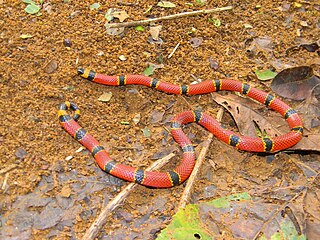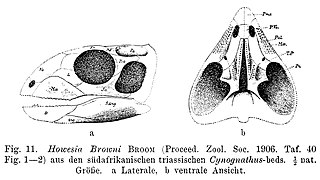
Stahleckeriidae is a family of dicynodont therapsids whose fossils are known from the Triassic of North America, South America, Asia and Africa.

The Kolombangara monarch, or Brown's monarch, is a species of bird in the family Monarchidae. It is endemic to Solomon Islands. Its natural habitat is subtropical or tropical moist lowland forests. It is threatened by habitat loss.

Brown's pademelon is a species of marsupial in the family Macropodidae. It is found in New Guinea. Its natural habitats are subtropical or tropical dry forests, dry savanna, subtropical or tropical dry shrubland, and subtropical or tropical dry lowland grassland. It is threatened by habitat loss.
Mesosuchus is an extinct genus of basal Rhynchosaur from early Middle Triassic deposits of Eastern Cape, South Africa. It is known from the holotype SAM 5882, a partial skeleton, and from the paratypes SAM 6046, SAM 6536, SAM 7416 and SAM 7701 from the Aliwal North Euparkeria site. Mesosuchus is quite small, spanning around 30 cm in length. Mesosuchus was discovered and named by David Meredith Seares Watson in 1912.

Catopithecus is an early catarrhine fossil. It is known from more than 16 specimens of a single species, Catopithecus browni, found in the Jebel Qatrani Formation of the Fayum Province, Egypt. The Jebel Qatrani Formation has been divided into two main faunal zones based on the fact that the fauna found in the lower portion of the quarry appear to be more primitive than those found in the upper section. The upper zone has been dated to older than 31 ± 1 myr based on the dating of a basalt layer that lies immediately above the formation and Nicolas Steno’s Law of Superposition. The lower zone contains the late Eocene green shale unit called Locality-41 (L-41) in which all the specimens of Catopithecus browni have been found. The relative dating of L-41 based on paleomagnetic correlations places it at 36 Myr according to Simons et al (1999), but Seiffert (2006) suggests this should be revised to 34.8-33.9 Myr.

Batrachosuchus is a genus of temnospondyl that existed from the Early to Middle Triassic of southern Africa and the Blina Shale of Australia.

Micrurus browni, commonly known as Brown's coral snake, is a species of venomous snake in the family Elapidae. The species is native to Guatemala and southwestern Mexico. There are three recognized subspecies, including the nominate subspecies described here.

Howesia is an extinct genus of basal rhynchosaur from early Middle Triassic deposits of Eastern Cape, South Africa. It is known from the holotype SAM 5884, a partial skeleton with palate and partial lower jaws and from two paratypes, SAM 5885 and SAM 5886. It was found in the Burgersdorp Formation of the middle deposits of the Beaufort Group and referred to Subzone B of the Cynognathus Assemblage Zone. It was first named by Robert Broom in 1905 and the type species is Howesia browni, named after Alfred Brown.
Acer browni is an extinct maple species in the family Sapindaceae described from a series of isolated fossil leaves and samaras. The species is known from the early to middle Miocene sediments exposed in Western Oregon, Washington state, USA and Northern Graham Island, Haida Gwaii, Canada. It is one of several extinct species placed in the living section Parviflora.

Gavialis browni is an extinct species of the crocodylian genus Gavialis and a close relative of the living gharial Gavialis gangeticus.

Noteosuchus is an extinct genus of basal rhynchosaur known from the earliest Triassic deposits of Eastern Cape Province, South Africa. It was first named by David Meredith Seares Watson in 1912 and the type species is Eosuchus colletti. The generic name Eosuchus is preoccupied by the generic name of Eosuchus lerichei Dollo, 1907, a gavialoid crocodilian known from northern France. Thus, an alternative generic name, Noteosuchus, was proposed by Robert Broom in 1925. The generic name erected by Broom (1925) is a compound, meaning "Not Eosuchus", while "Eosuchus" is derived from the name of Eos, the goddess of the dawn in Greek mythology, and suchus, Latinized from the Greek souchos, an Egyptian crocodile god, thus meaning "dawn crocodile". The specific name, colletti, honors Mr. Collett for the discovery of the holotype and only known specimen.

Parmenini is a tribe of longhorn beetles of the subfamily Lamiinae.
Harley Procter Brown Jr. was an American biologist and an expert in certain types of aquatic beetles. He described over forty new species in his career.
Microtragus arachne is a species of beetle in the family Cerambycidae. It was described by Francis Polkinghorne Pascoe in 1865. It is known from Australia.
Microtragus basalis is a species of beetle in the family Cerambycidae. It was described by Lea in 1917. It is known from Australia.
Microtragus bifasciatus is a species of beetle in the family Cerambycidae. It was described by Lea in 1917. It is known from Australia.
Microtragus cristulatus is a species of beetle in the family Cerambycidae. It was described by Per Olof Christopher Aurivillius in 1917 and is known from Australia.
Microtragus luctuosus is a species of beetle in the family Cerambycidae. It was described by Shuckard in 1838. It is known from Australia.
Microtragus senex is a species of beetle in the family Cerambycidae. It was described by White in 1846. It is known from Australia.
Microtragus tuberculatus is an Australian species of beetle in the family Cerambycidae, which was described by Carter in 1934.









